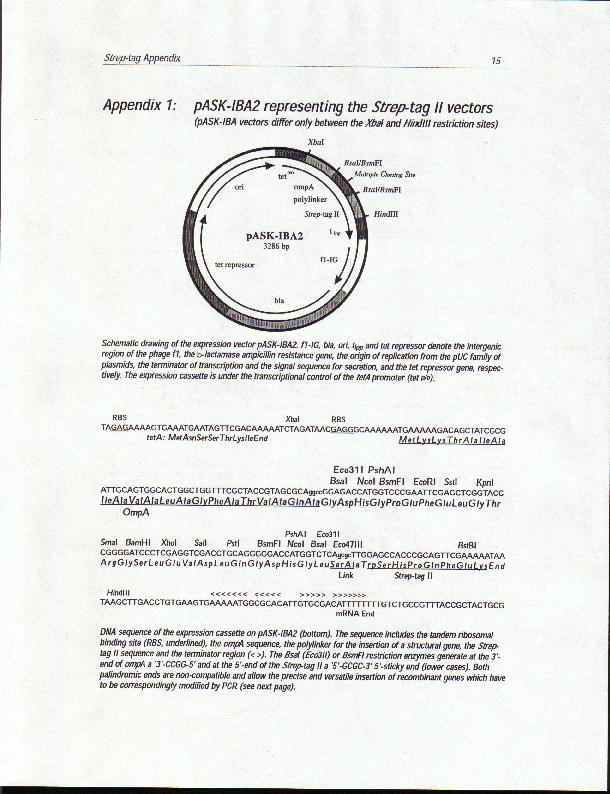Method:
Strep-Tag is an eight
amino acid polypeptide that is translated directly downstream of a DNA
insert in a vector expression system.1 When the DNA that
you want translated is expressed into protein, it is bound to the eight
amino acid Strep-Tag.1 The merits of Strep Tag are two-fold:
first, the Strep-Tag system is purchased as a vector with a promotor (tet
A) that is tightly repressed by tet R. This makes the system ideal
for expression of toxic proteins, since uncontrolled expression of such
protein could easily result in the death of the host cell E.coli.1
The second benefit of the Strep-Tag vector is that the eight amino acid
Strep-Tag is chemically inactive. This means that the Strep-Tag will
not disrupt the structural folding of the protein under study.1
Thus, one studying the function of this protein in an expression system
should see the same results whether the protein is fused with Strep-Tag
or not. However, it must be noted that if no modification can occur
at all, then a modified Strep-Tag vector can be purchased that puts a signal
sequence next to the Strep-Tag insert. This signal sequence functions
to place the fused protein in a region of E.coli where the eight amino
acid Strep-Tag insert can be cleaved.2
The Strep-Tag vector
is perfectly suited for studying a protein from a known piece of cDNA.
To extract your desired piece of cDNA, one can first make a genomic library.3
Then, to find the cDNA of interest, one can transfer the cells to a nitrocellulose
filter, while denaturing the dsDNA into ssDna in the process.3
An appropriately labeled DNA probe must then be exposed to the filter,
after blocking the filter, to show which colony is producing the cDNA of
interest.3 After isolating and sequencing the cDNA of
interest, one must modify the cDNA so that it will be expressed in the
Strep-Tag vector. To do so, PCR must be employed. Moreover,
the primers must have the appropriate sticky ends for the Bsal restriction
site since it is this restriction site that is used to cut the Strep-Tag
vector.2 The Bsal restriction site is adjacent to the
Strep-Tag sequence.2 Cutting the vector with Bsal and
subsequently ligating it with the PCR product ensures that when induction
occurs, the Strep-Tag protein will be fused with the protein of interest.2
Screening for positive transformation with the host cells is done on an
ampicillin medium as the vector contains a gene for ampicillin resistance.2
After the desired colonies
have been selected, one must induce protein synthesis. As said before,
tetR codes for a repressor that keeps the tetA promotor in check.4
This is important in that it keeps potentially toxic proteins from being
expressed prematurely.1 The addition of anhydrotetracycline
effectively induces protein synthesis since anhydrotetracycline binds to
the tet R repressor, which releases it from the operator, and allows the
promotor to function.4
Isolation and identification
of the protein of interest may be undertaken with either a Western blot
or column chromatography.1 The Strep-Tag makes both of
these methods possible becasue this eight amino acid has a high binding
affinity for streptavidin (a glycoprotein) and Strep Tactin ( a modified
form of streptavidin).1 For Western blots, one must isolate
the proteins from the rest of the medium using the proper protocol.2
After performing an SDS Page with the protein mixture, one can transfer
the bands to a filter, which is appropriately blocked and subsequently
exposed to labeled streptavidin.2 The complex that forms
between Strep-Tag, streptavidin, and another protein label (see protocol)2
gives off light in a dark setting and allows for identification of the
protein of interest.
Column chromatography
is similar to a Western blot in that the separation of the fused protein
from the rest of the protein mixture occurs due to binding of the column
(Strep Tactin) with the Strep-Tag fusion protein. After the protein
mixture has been sent through the column using proper protocol, biotin
(a vitamin containing a carboxyl terminus)5 is sent through
the column so as to separate proteins that have a weak interaction with
the column from proteins such as Strep-Tag, which have a high affinity
for the column.

Fig.1
This is an image of the Strep-Tag II vector.
Permission for this image is currently being sought from the Genosys Corporation.
If permission is not given, the image will be removed immediately.
To see the original image, go to www.genosys.com/prod.01.html
oReferences
1) Genosys Biotechnologies Strep-Tag Product
Page. <http://www.genosys.com/prod.01.html>
Accessed 00 Feb. 19.
2) Genosys Biotechnologies Strep-Tag Instruction
Manual. <http://www.genosys.com/prod.01.html>
Accessed 00 Feb 19.
3) Campbell, N.A. Biology Fourth Edition. The
Benjamin Publishing Company, Inc. 1996. pp. 370-374
4) Bechhofer, DH and Stasinopoulos, SJ.
tetA(L)
mutans of a tetracycline sensitive strain of Bacillus subtilis with the
polynucleotide phosphorylase gene deleted. Journal of Bacteriology. 1998
July; 180(13) 3470-3
5) Lehninger, A.L. Biochemistry. Worth Publishing,
Inc. 1975. p. 274
Click here to return
to the main page
For questions or comments, email
me at seburke@davidson.edu
Return
to Davidson College Biology Department Home Page
Return
to Davidson College Homepage